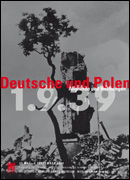


Exhibition | Oppression and Self-assertion | War and Occupation | Conflicts and Rapprochements
The Invasion
| Forced Labor
| Colonization, Deportation, Extermination
Genocide
| Resistance and Self-assertion
The End of the War
| Expulsion of the Germans
| Expulsion of the Poles
In spring of 1940, the German occupiers began to concentrate the Jewish population in ghettos, where thousands of people died every month as a result of the catastrophic living conditions, succumbing to hunger, disease, illness and exhaustion.
With the invasion of the Soviet Union on 22 June 1941, the Nazi plan to systematically murder the Jews was put into operation, as Einsatzgruppen perpetrated mass shootings in the occupied areas of Eastern Poland and the Soviet Union. By the end of 1941, 500,000 Jewish men, women and children had been murdered in this fashion.
In 1942, the Nazi regime launched a coordinated campaign to murder Jews everywhere in Europe, as well as the Roma and Sinti. Jews living in areas under Nazi control were deported to ghettos and death camps in occupied Poland. The largest death camp was Auschwitz-Birkenau, where the SS murdered about 1.1 million people, about 90 percent of them Jews.
